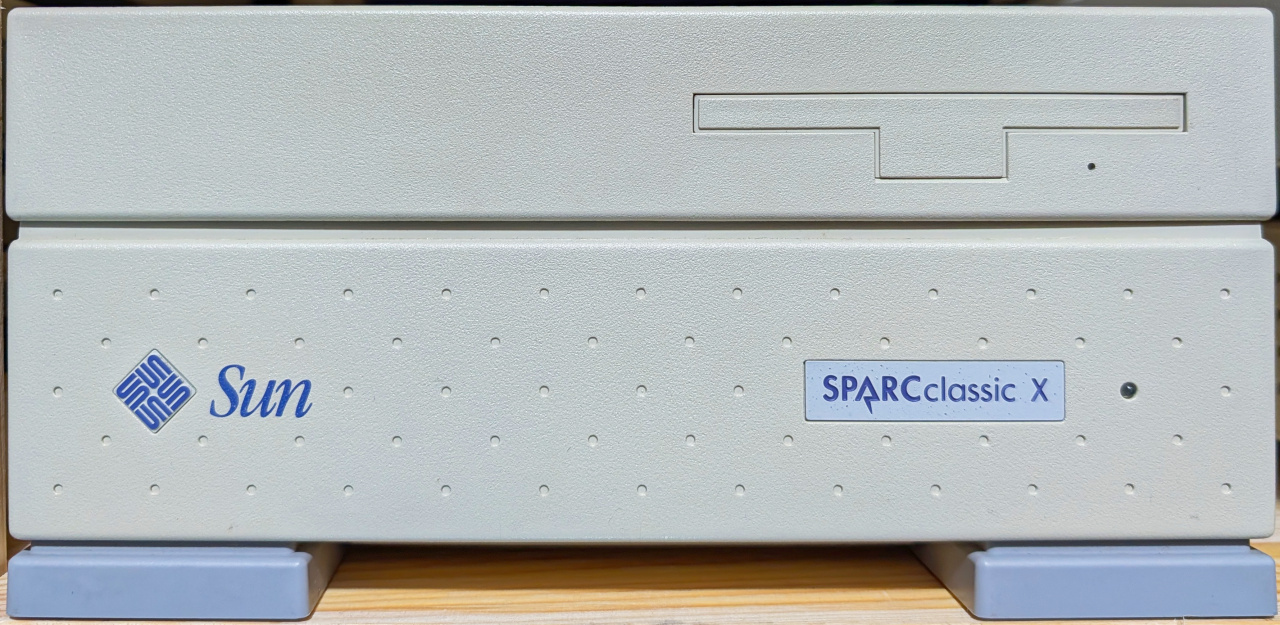SPARCclassic X (Sun 4/10)
Gallery

Image of OSfOM.org Collection's SPARCclassic X (Sun 4/10).
Technical Specifications
| Model: | SPARCclassic X (Sun 4/10) |
|---|---|
| Codename: Platform: |
Hamlet sun4m |
| Processor: Math Copro: |
microSPARC (in CPU) |
| Clock Speed: | 50MHz |
| RAM: | max. 96MB |
| Graphics: | onboard CG3 |
| Operating System: | SunOS 4.1.3c to 5.9 (Solaris 9) - Linux, NetBSD, OpenBSD |
| Introduced: | July 1993 |
| Dealer price (net): | 6.550DM (4MB RAM, 19" greyscale display) (Dec. 1993) |
The Ultimate Budget UNIX Box: A Look Back at the SPARCclassic X
In the mid-1990s, Sun Microsystems, seeking to defend its market share against the rising tide of powerful Intel-based PCs, needed a workstation that was reliable, ran the robust Solaris operating system, and—most importantly—was aggressively priced. This need gave rise to the SPARCclassic X, a highly streamlined and cost-effective iteration of the popular SPARCclassic workstation.
Launched in 1993, the SPARCclassic X wasn't about blazing speed; it was about value and accessibility, making the powerful SPARC/Solaris ecosystem available to a wider audience, particularly universities, software developers, and government agencies with tight budgets.
Stripping Down to Essentials: What Made the 'X'
The SPARCclassic X was essentially a lower-cost variant of the original SPARCclassic, which itself was one of the first machines to integrate the MicroSPARC processor. The "X" designation often signified a diskless configuration or a version specifically built for mass-market value, a strategy Sun employed to simplify inventory and reduce the sticker price.
Key features and compromises that defined the SPARCclassic X:
- Processor: It was powered by the integrated MicroSPARC processor. This chip provided a strong balance of performance for its time and offered excellent integration, reducing the complexity and cost of the motherboard.
- Form Factor: The machine featured the recognizable, compact "lunchbox" or "shoebox" desktop design common to the SPARCclassic series.
- Diskless Operation (The 'X' Factor): While some models were sold with drives, the most notable configuration of the SPARCclassic X was its diskless nature. These machines were designed to network boot from a central server, making them true thin-client workstations. This dramatically reduced the hardware cost per seat and simplified system administration, as all user files and the operating system resided on central, managed servers.
- Integrated Graphics: To save costs, the SPARCclassic X relied on integrated graphics, perfectly adequate for the Common Desktop Environment (CDE) and core development applications, but not for high-end visualization.
Solaris OS: It ran the full, robust Solaris operating system, providing the stability and powerful UNIX environment that professionals required.
The Workhorse for the Masses
The SPARCclassic X was a pivotal machine in Sun's efforts to keep its UNIX platform relevant against the growing dominance of Windows NT and Linux on x86 hardware.
Its core audience included:
- Universities and Education: Ideal for computer labs, offering a reliable, centralized environment where dozens of machines could be managed and wiped clean from a single server.
- Software Developers: Essential for developers needing a low-cost machine for compiling and testing applications specifically for the SPARC/Solaris platform.
- Network Infrastructure: Used extensively as dedicated network nodes, build servers, or specialized management consoles.
The SPARCclassic X proved the immense value of centralized management and low Total Cost of Ownership (TCO). Its reliable, diskless architecture meant fewer moving parts to fail and simplified system maintenance, making it the epitome of Sun's network computing philosophy: "The network is the computer."
Today, the SPARCclassic X is remembered as a rugged, dependable gateway machine that introduced countless developers and institutions to the powerful world of UNIX and the robust reliability of the SPARC architecture.